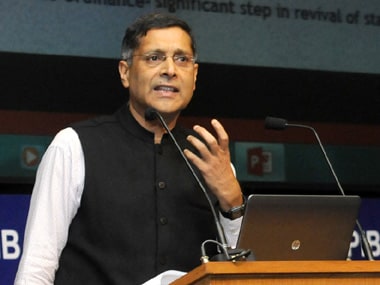The government has tabled the mid-year economic review in Parliament today. The review has cut the growth forecast for the current financial year to 7-7.5 percent from earlier estimate of 8.1-8.5 percent. Here are five takeaways from the report authored by chief economic advisor Arvind Subramanian: [caption id=“attachment_2265390” align=“alignleft” width=“380”]  Chief economic adviser Arvind Subramanian. Image courtesy PIB[/caption] India can still be the fastest growing: The government cut its GDP growth forecast for 2015-16 to 7-7.5 percent from 8.1-8.5 percent estimated in the economic survey in February 2015. The reason for the cut is the weak global demand and slower nominal GDP growth because of domestic factors such as lower-than-expected disinvestment receipts and tax collections. According to the report, the nominal GDP growth has declined substantially to 7.4 percent in the first half of current financial year from from 13.5 percent in the year-ago period. Also the second consecutive year of deficient monsoon is threatening to hit farm output, adding to the stress in the rural economy. The economy has grown 7.2 percent in the first half of the fiscal year. Interestingly, even with the lowered GDP growth, India can remain the world’s fastest growing major economy as China’s GDP is struggling to maintain the near-7 percent pace. Fiscal deficit a concern: The report has said the decline in nominal GDP growth will pose a challenge for meeting the fiscal deficit target of 3.9 percent of GDP - an eight-year low - for the current fiscal year. The fiscal outlook for 2016-17 looks challenging too and the government will need to reassess its commitment to cut the deficit further by 0.4 percent of GDP in the financial year that begins in April, the report has cautioned. As per the government’s fiscal consolidation road map, the country is to cut the deficit to 3.5 percent in 2016-17 and progressively reduce to 3 percent by 2017-18. However, many experts have cautioned the government should not get obsessed about the fiscal deficit target as public spending is key to the economic revival. However, what has rendered meeting the target a herculian task is the Seventh Pay Commission recommendations that will result in an outgo of Rs 1.02 lakh crore in 2016-17, of which the central government accounts for two-third and likely less corporate tax collection. “The proposed wage hike for government workers may impact plan for next fiscal,” the report said. Falling exports putting a drag: Slowing demand overseas has hit growth as exports have been falling for the past 12 months. The exports account for about a fifth of India’s $2 trillion economy. “Declining exports seem to be predominantly determined by a decline in the world demand. Regardless of the causes, the effect has been a drag on growth,” the report has said. The decline has put a question mark over prime minister Narendra Modi’s Make in India campaign, which seeks to steal China’s thunder. Inflation target achievable: The report has set retail inflation target at 6 percent by the end of March 2016. It suggested whether the country needed a more flexible timeline for its inflation targets given the need to help indebted companies lower their debt levels. “How can borrowing costs be lowered without jeopardising the medium term inflation objective?” the report asked. “Is there a case for a more gradual glide path or greater flexibility in interpreting the inflation objective?” Reserve Bank of India Governor Raghuram Rajan has set a target for consumer inflation of 5 percent by March 2017 and 4 percent in the medium term, as part of his “glided path” approach to monetary policy. A section of experts feel that this target is achievable as it is a conservative estimate. Barclays Economist Siddharth Sanyal is one who thinks so. “I am expecting average inflation for FY16 at 5 percent, and slightly higher for FY17,” he told CNBC-TV18 in an interview. Setting up of public debt management agency: The report says the finance ministry also plans to set up a public debt management agency (PDMA) through an executive order. PDMA has been a contentious issue as the RBI had certain reservations about the timing of the creation of such an agency. “Detailed road map has been prepared for establishing PDMA. Consultations with RBI are going on,” the report said. With inputs from Reuters, PTI
The government has tabled the mid-year economic review in Parliament today. The review has cut the growth forecast for the current financial year to 7-7.5 percent from earlier estimate of 8.1-8.5 percent. Here are five takeaways from the report authored by chief economic advisor Arvind Subramanian: [caption id=“attachment_2265390” align=“alignleft” width=“380”]  Chief economic adviser Arvind Subramanian. Image courtesy PIB[/caption] India can still be the fastest growing: The government cut its GDP growth forecast for 2015-16 to 7-7.
Advertisement
End of Article


)

)
)
)
)
)
)
)
)



